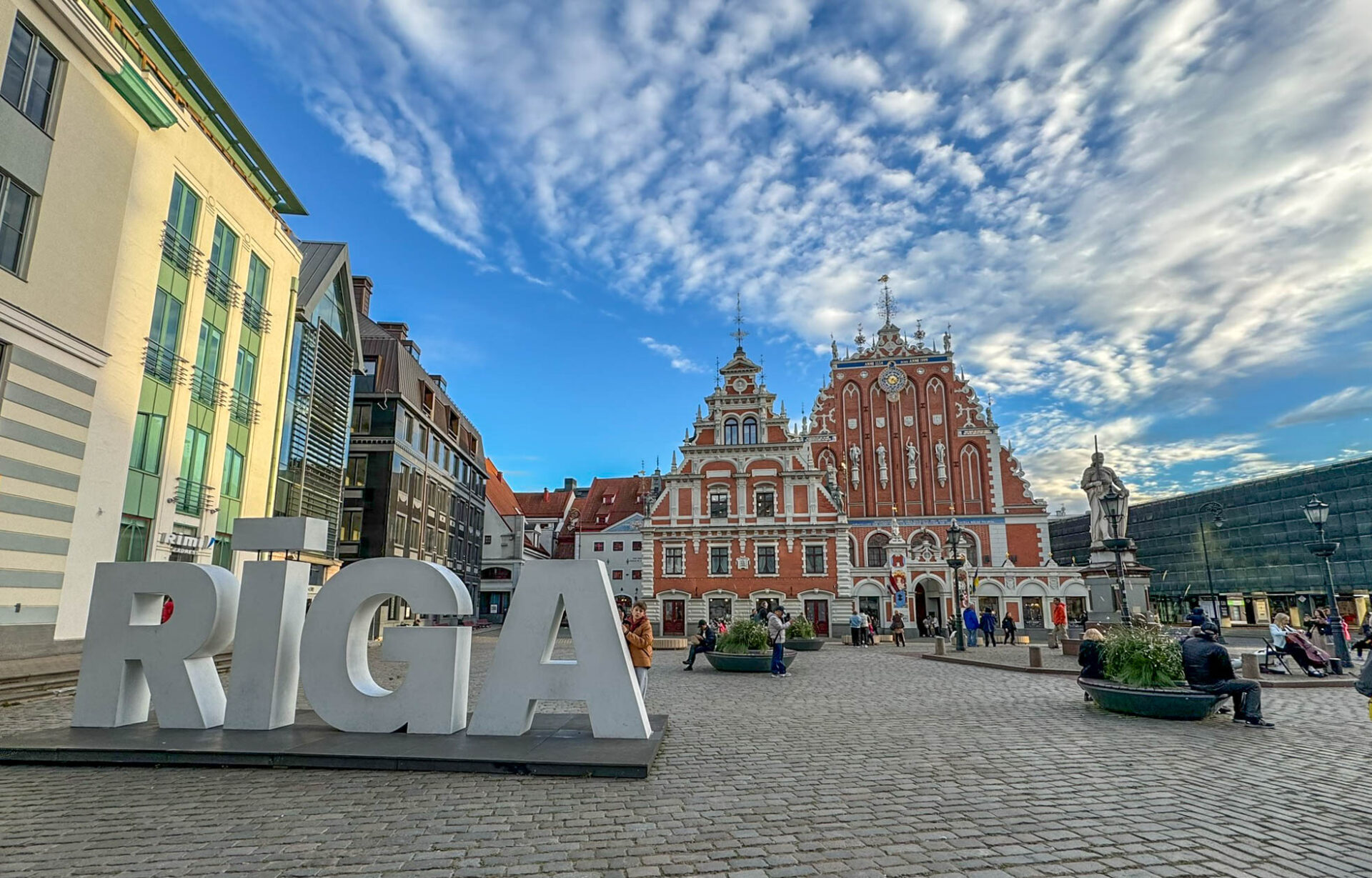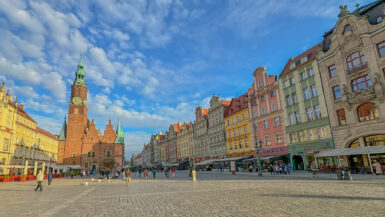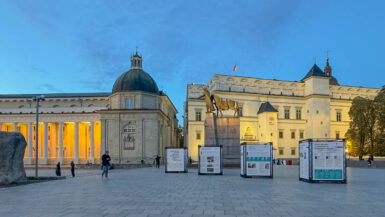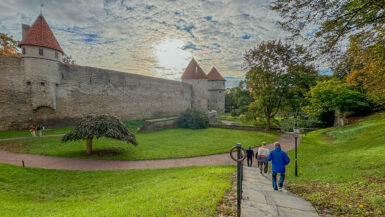Your Latvia Road Trip Playlist: Gauja National Park, Sigulda Bobsleigh and Luge Track, and the capital city of Riga.
In my last two posts, I shared some background on the Baltics and highlighted a few gems in Estonia. Now, we’re hitting the road again, this time heading into Latvia – a place where you’ll find centuries-old history, stunning landscapes, and a capital city that knows how to keep things lively. Along the way, we’ll explore the country’s largest and oldest National Park (Gauja National Park), make a stop in the town of Sigulda to check out it’s bobsleigh and luge track, and wrap up with a visit to Latvia’s vibrant and colorful capital, Riga. I hope you enjoy the tour!


Table of Contents
Gauja National Park: Latvia’s Natural Masterpiece
Founded in 1973, Gauja National Park holds the title of Latvia’s largest and oldest national park. Spanning over 350 square miles (900 square kilometers), it’s a tad bigger than Shenandoah National Park in Virginia. The park is known for its rich cultural sites, stunning scenery, and diverse landscapes that include old-growth forests, wetlands, sandstone cliffs, and caves.
With over 350 miles (560 kilometers) of marked hiking paths and nearly 200 miles (320 kilometers) of cycling trails, there’s no shortage of ways to get some exercise in Gauja National Park. Whether you prefer forest roads, smooth paved routes, or rugged mountain biking trails, you’ll find something that suits your style. If water’s more your thing, the Gauja River is great for kayaking and canoeing. Winter doesn’t slow things down either. Cross-country skiing, downhill skiing, snowboarding, and snowshoeing are all on the table. Let’s just say, if you love the outdoors, you won’t be twiddling your thumbs here.
Since we had limited time to explore, we decided to focus on the Turaida Museum Reserve. Why, you ask? A little pre-trip Googling promised a mix of historic buildings, intriguing sculptures, and impressive views of Gauja National Park. Plus, I’d somehow managed to catch a flu-like bug during my earlier travels. Needless to say, the idea of hiking or biking wasn’t anywhere near the top of my wish list in the condition I was in.

During our visit, we discovered that the Turaida Museum Reserve is not only a treasure trove of history, but it’s also intended to preserve the legacy of the Livonian Order along with a hearty dose of Latvian folklore and traditions. Of course, I’d never heard of the “Livonian Order”, so here’s the quick version, so we can both pretend we’re history buffs.
The Livonian Order was an offshoot of the Teutonic Order (a Catholic religious military order), and it controlled Latvia and Estonia from the 13th to 16th centuries. Their main goal? Converting local pagan tribes during the Northern Crusades. To cement their power, they constructed impressive fortresses like Turaida Castle, which we had a chance to visit.
The Livonian Order government was a mix of theocracy and German-style feudalism. They called the shots on land ownership, trade, and taxes. But all that power didn’t exactly make them popular. Locals resisted, and neighboring heavyweights like Russia, Poland, and Sweden weren’t thrilled either. Things came to a head with the Livonian War (1558–1583), which ultimately unraveled their rule. This brings up the question, “who fought in the Livonian War?”
The Livonian War was all about who got to call the shots in the Baltic region, especially in Livonia—what we now know as Latvia and Estonia. The main players in this historical tug-of-war were Livonia, Russia, Poland-Lithuania, Sweden, and Denmark. Each of them had their eyes on dominating Northern Europe,
So, how did it wrap up? Well, Poland-Lithuania ended up controlling southern Livonia, while Sweden locked down northern Livonia and Estonia. By 1561, the Livonian Order was no more. Even though their reign ended, they left behind quite the legacy. Castles, churches, and their influence on laws and culture still play a part in shaping the history of Latvia and Estonia.
Rather than signal an end to the fighting, the Livonian War marked the beginning of a long struggle for Baltic dominance that continued through the 17th century, culminating in the Swedish Empire’s rise and later conflicts with Russia during the Great Northern War (1700–1721). As you can tell, there’s been no shortage of wars in this region over the years and we’ll leave it at that.
Rather than continue to ramble on about the region’s rough history, let’s enjoy a photo tour that will hopefully give you a flavor of what to expect while visiting the Turaida Museum Reserve of Gauja National Park.





















Sigulda: The Switzerland of Vidzeme
Tucked away near Gauja National Park, the city of Sigulda has earned the nickname “Switzerland of Vidzeme” for its rolling hills and picturesque views. Having spent a year in the Swiss ski resort town of Gstaad, I can confidently say the comparison is … well, a little ambitious. For starters, the highest point in Gauja National Park is 160 meters (525 feet) above sea level. Meanwhile, Switzerland’s Dufourspitze (part of the Monte Rosa massif) comes in at a whopping 4,634 meters (15,203 feet). That’s not exactly apples to apples. It’s more like comparing skiing in Michigan to the powder-filled slopes of Utah, Colorado, or northern New Mexico. Yes, I couldn’t pass up an opportunity to sneak in a shoutout to Taos Ski Valley. After all, this blog is focused on New Mexico, or at least it’s supposed to.
Ok, let’s get back to Sigulda, Latvia.
The town of Sigulda, Latvia
Just an hour outside of Riga, the town of Sigulda (home to about 150,000 people) is a mix of scenic spots, historic landmarks, and plenty of dining options. Two of its big draws are the Sigulda Medieval Castle and Gutmanis Cave. However, we were only there for two reasons: grabbing lunch and, more importantly, checking out the legendary bobsleigh and luge track.
With around 30 restaurants scattered throughout Sigulda, there’s enough variety to satisfy most cravings. We had the chance to poke our head in a few places during our search for lunch.






Sigulda Bobsleigh and Luge Track
Back in the late 1800s, Switzerland became the birthplace of a sport that got people sliding down icy tracks at terrifying speeds. They called it “bobsleigh.” That’s still the go-to term in British English, which is used across most of Europe and in many English-speaking countries outside the U.S. But, in typical fashion, Americans decided to put their own spin on it and named it “bobsled.” Same sport, just a different word depending on where you’re from.
Fast forward to 1986, when the Sigulda Bobsleigh and Luge Track opened its doors and became a hotspot for international competitions. It also happens to be one of Latvia’s more popular attractions for tourists.
Now, you might be wondering, “What’s so exciting about visiting a bobsleigh and luge track?” Well, here’s the twist: Sigulda’s track isn’t just for the pros. Regular folks can hop in and experience a ride for themselves. Yes, you can actually feel the rush of flying down a bobsleigh and luge track firsthand.
This competition bobsleigh and luge track stretches 4,660 feet (1,420 meters) and features 16 curves that will have you gripping tight. Professional athletes on this course can hit speeds up to 77 mph (125 km/h) while enduring G-forces as high as 5 Gs on some of the sharper bends. Don’t worry, though – you won’t be going that fast. For public rides, they use modified options like “soft-bobs,” “soft-luges,” ice rafts in the winter, and wheeled bobsleighs during the summer. These rides can still reach speeds of up to 50 mph (80 km/h), which is more than enough to give you an adrenaline kick.
So, if you’re up for a mix of thrills and bragging rights, Sigulda Bobsleigh and Luge Track has you covered. Here’s a quick rundown of the types of rides they offer for the public.
Winter Season (November to mid-March):
- Soft-Bob: Picture yourself zipping down an icy track in a soft-bob, which is basically a bobsleigh, but softer. It’s bobsledding without the scary Olympic-level intensity.
- Soft-luge: This one lets you channel your inner luge champion in a setup that’s both thrilling and safe. It’s like sledding’s cooler, faster cousin.
- Ice-Rafting: Sort of like inner-tubing down a river, but with a lot more screaming.
Summer Season (Early May to Late September):
- Summer-Bob Ride: No ice? No problem. In the summer, the bobsleigh gets a makeover with wheels, so you can still speed down the track, but on concrete. It’s fast, it’s fun, and you’ll probably want to go again.
The track is open daily from 8:00 AM to 8:00 PM, giving you plenty of time to muster up the courage to try these activities. For up-to-date details on rides and schedules, it’s best to reach out to the track directly or check with local tour guides.
Why didn’t I share my firsthand experience of hurtling down a bobsleigh track? Well, because we showed up exactly one day after they wrapped up their summer season. Just ONE day! Talk about bad timing. So, there are no thrilling personal anecdotes from me. Instead, here’s a link to the Sigulda Bobsleigh and Luge Track website so you can check out what it’s all about and purchase tickets in advance. Hopefully, it gives you a glimpse of what to expect.
All I’ve got to show for now are these two lame photos. Sigh. Hopefully another year.


Riga: A Fusion of History and Modernity
Our final stop was Riga, the bustling capital and largest city of Latvia. Riga, like its Baltic siblings, pulls off a nice mix of old and new without breaking a sweat. Some of Riga’s highlights include:
- Old Town (Vecrīga): A UNESCO World Heritage site, Riga’s Old Town is a maze of cobblestone streets, historic buildings, and lively squares. Riga’s Old Town is packed with landmarks like the impressive Riga Cathedral, the towering St. Peter’s Church, and the striking House of the Black Heads.
- Art Nouveau District: To be honest, if you asked me to point out exactly what makes something “Art Nouveau,” I’d probably just shrug and gesture vaguely at anything that looks fancy. But with about one-third of Riga’s buildings falling into the Art Nouveau category, my odds of getting it right would be high. That’s particularly true in Riga’s Art Nouveau District, which is basically like having the Art Nouveau answer key right in front of you.
- Central Market: Housed in former Zeppelin hangars, this bustling market offers a taste of local life. Here, you can sample Latvian delicacies, purchase fresh produce, and experience the city’s vibrant atmosphere.
Similar to the approach I took in my blog post about Tallinn, Estonia, here’s a collection of photos from Riga with captions that (hopefully) give you a feel for the city.









Eating and Drinking in Old Town Riga
Old Town Riga is packed with taverns, cafés, and bistros that cover all the bases. Craving local eats? You can find traditional Latvian dishes that include smoky fish, hearty grey peas, and dense rye bread. You may also want to sample Riga Black Balsam, a traditional Latvian herbal liqueur with a deep, rich, and slightly bitter flavor. Created in 1752 by Abraham Kunze, a pharmacist from Riga, it is one of the most iconic beverages in Latvia. With 24 plants, roots, berries, and spices aged in oak barrels, it’s said to offer some potential health benefits. I’m guessing Riga Black Balsam earns some extra love for being 45% ABV (90 proof). Regardless, it’s safe to say that Riga has a reputation for being a lively hotspot for nightlife.














In Closing
I hope this little photo journey through Gauja National Park, Sigulda, and Riga sparks some ideas for your trip to Latvia! As usual, we just skimmed the surface of what Latvia has to offer. There’s so much more to explore, and I wouldn’t hesitate to go back someday.
Next stop: Lithuania.
Thought for the Week
This week, I thought it’d be fun (and maybe a little inspiring) to share three Latvian quotes that caught my eye. Two of them come from Rūdolfs Blaumanis, the Latvian writer who was featured in one of the photos I shared above from a park in Riga.
Let’s start with the first quote from Blaumanis. He points out something we all wrestle with: figuring out whether we truly can’t do something or if we’re just not willing to try. It’s one of those truths that stings a little because, let’s face it, we’ve all been there. His words challenge us to take a closer look at the obstacles in our lives and ask, “Is this really impossible, or am I just telling myself it is?”
The second quote from Blaumanis explores the emotional distance and coldness that can develop between people when kindness or goodwill is repeatedly rejected. The quote serves as a reminder that accepting kindness and allowing others to help or connect with us is crucial to maintain healthy relationships. It warns against the dangers of pride and stubbornness in human interactions.
Finally, we close with a quote from Latvian poet and writer Imants Ziedonis (1934 – 2013) on the topic of dreaming big. It’s a simple idea, but it packs a punch. Dreams aren’t just some distant, fluffy concept. They’re what keep us moving forward, shaping our choices and giving us a reason to get out of bed in the morning. Well, besides coffee … or in my case, green sludge smoothies. Big dreams matter. They’re supposed to feel intimidating and nudge us out of our comfort zones. Let’s face it, life isn’t a smooth, perfectly paved highway. It’s more like a bumpy dirt road full of unexpected twists. But those big dreams? They’re what keeps us moving, especially when everything feels like it’s falling apart. So no, dreaming isn’t just wishful thinking. It’s what gives life some direction and purpose. Ziedonis encourages us to dream big, take a breath, and see where those dreams can take us.
“Our misfortune is that we never know exactly where our inability ends and our unwillingness begins.” (“Mūsu nelaime ir tā, ka mēs nekad skaidri nezinām, kur mūsu nevarēšana beidzas un mūsu negribēšana iesākas.”)
― Rūdolfs Blaumanis
“Nothing freezes a person from man faster and more fully than a stubbornly rejected favor.” (“Nekas neatsaldē cilvēku no cilvēka ātrāk un pilnīgāk kā spītīgi atraidīta labvēlība.”)
― Rūdolfs Blaumanis
“Dream big, because dreams are the roads we walk on.” (“Sapņojiet lielus sapņus, jo sapņi ir ceļi, pa kuriem mēs ejam.”)
― Imants Ziedonis
Thanks for reading and happy travels!
Mark (The New Mexico Travel Guy)

Mark Aspelin, The New Mexico Travel Guy (www.newmexicotravelguy.com), is a travel writer, conservation biologist, project manager, and author of two books. He’s visited over 100 countries and all 50 U.S. states—just enough to land in the Travelers’ Century Club and make choosing a favorite place nearly impossible. He’s currently on a questionable mission to visit every town in New Mexico (there are over 500) and write a story about each one, with plans to wrap it up sometime before his early to mid 100s. Mark balances his writing with conservation and project work from his home base in the East Mountains near Albuquerque, New Mexico.




